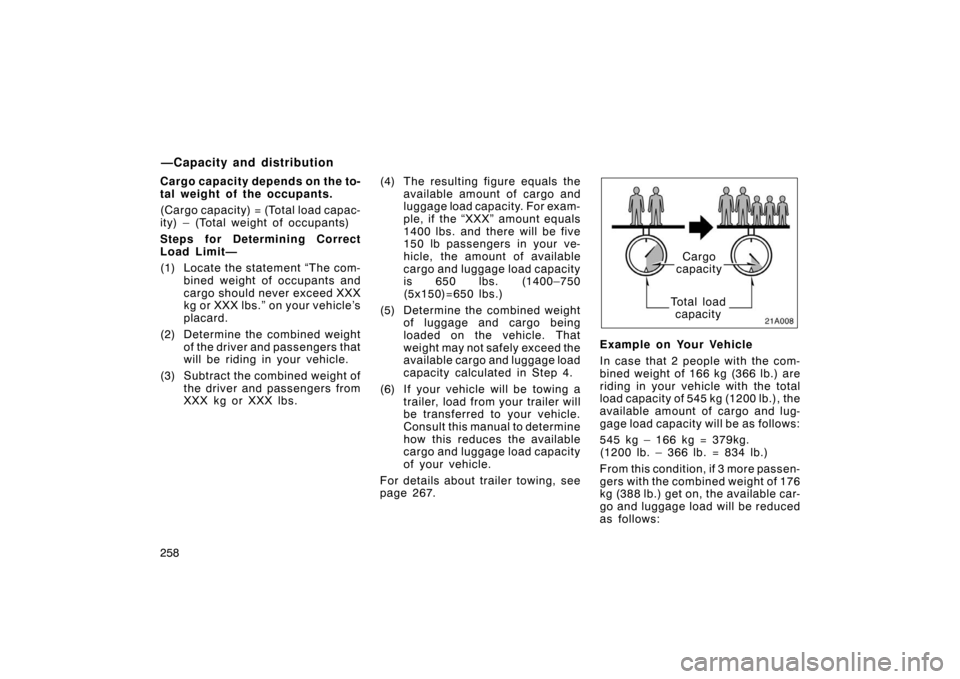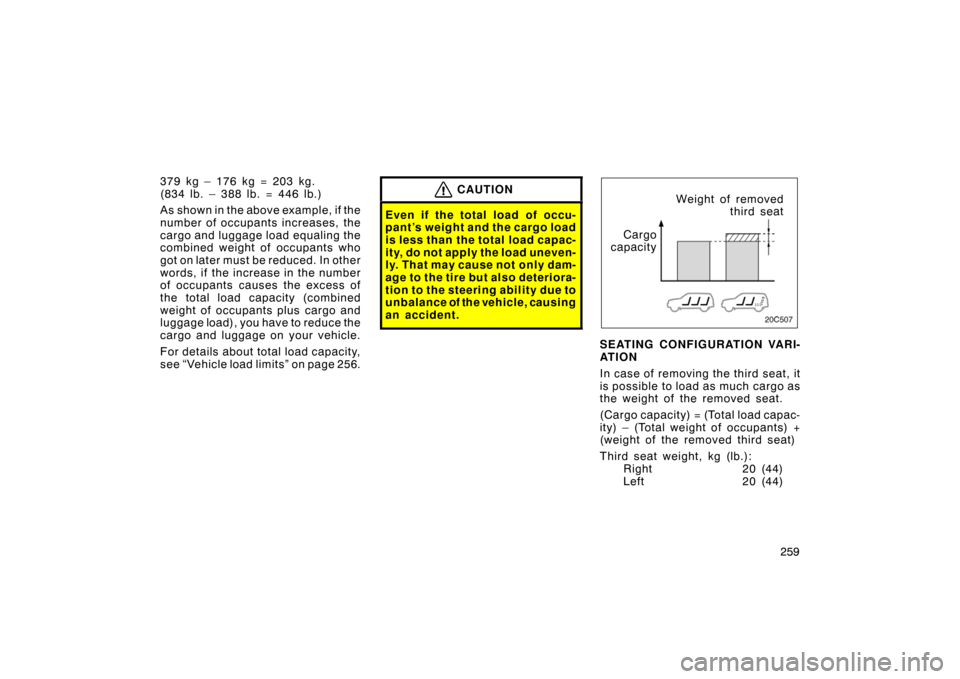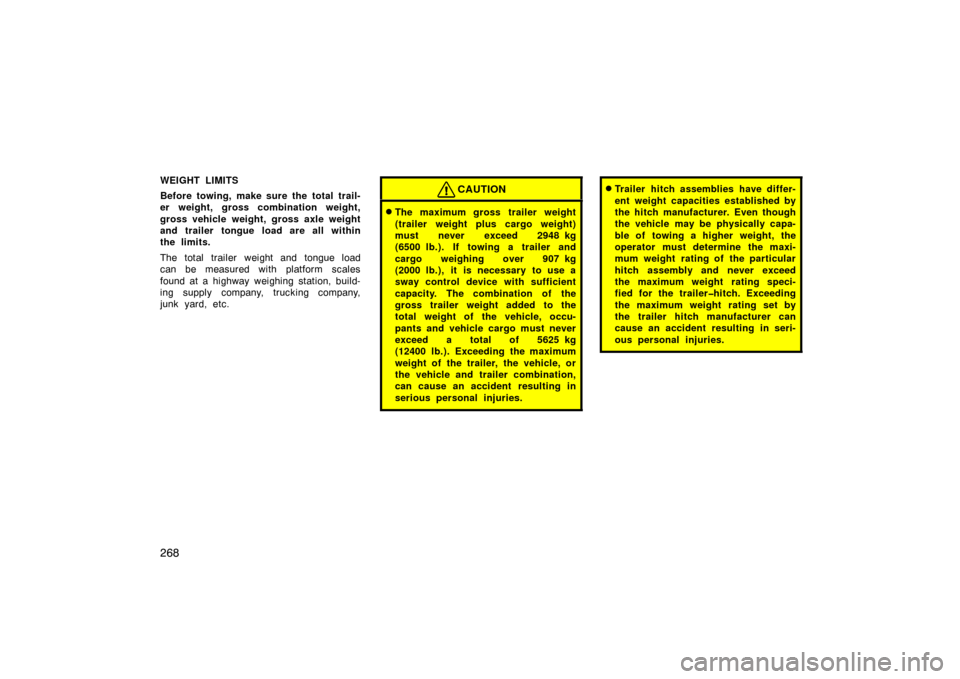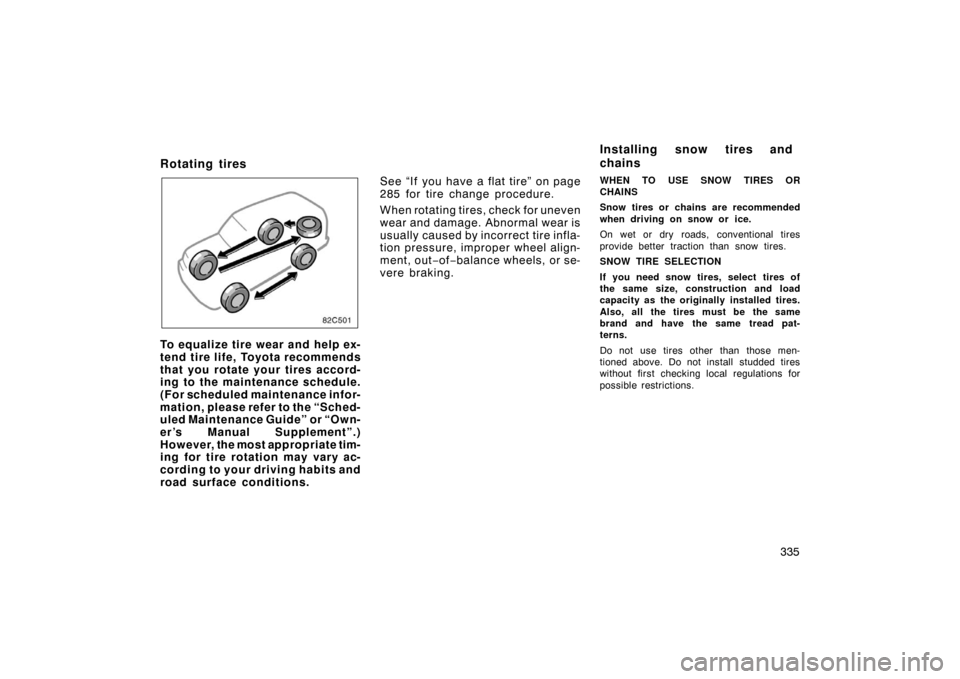Page 272 of 374

258 Cargo capacity depends on the to-
tal weight of the occupants.
(Cargo capacity) = (Total load capac-
ity) – (Total weight of occupants)
Steps for Determining Correct
Load Limit—
(1) Locate the statement “The com-bined weight of occupants and
cargo should never exceed XXX
kg or XXX lbs.” on your vehicle’s
placard.
(2) Determine the combined weight of the driver and passengers that
will be riding in your vehicle.
(3) Subtract the combined weight of the driver and passengers from
XXX kg or XXX lbs. (4) The resulting figure equals the
available amount of cargo and
luggage load capacity. For exam-
ple, if the “ XXX” amount equals
1400 lbs. and there will be five
150 lb passengers in your ve-
hicle, the amount of available
cargo and luggage load capacity
is 650 lbs. (1400–750
(5x150)=650 lbs.)
(5) Determine the combined weight of luggage and cargo being
loaded on the vehicle. That
weight may not safely exceed the
available cargo and luggage load
capacity calculated in Step 4.
(6) If your vehicle will be towing a trailer, load from your trailer will
be transferred to your vehicle.
Consult this manual to determine
how this reduces the available
cargo and luggage load capacity
of your vehicle.
For details about trailer towing, see
page 267.
Total load capacity Cargo
capacity
Example on Your Vehicle
In case that 2 people with the com-
bined weight of 166 kg (366 lb.) are
riding in your vehicle with the total
load capacity of 545 kg (1200 lb.), the
available amount of cargo and lug-
gage load capacity will be as follows:
545 kg – 166 kg = 379kg.
(1200 lb. – 366 lb. = 834 lb.)
From this condition, if 3 more passen-
gers with the combined weight of 176
kg (388 lb.) get on , the av ailable car-
go and luggage load will be reduced
as follows:
—Capacity and distribution
Page 273 of 374

259
379 kg – 176 kg = 203 kg.
( 834 lb. – 388 lb. = 446 lb. )
As shown in the above example, if the
number of occupants increases, the
cargo and luggage load equaling the
combined weight of occupants who
got on later must be reduced. In other
words, if the incr
ease in the number
of occupants causes the excess of
the total load capacity (combined
weight of occupants plus cargo and
luggage load), you have to reduce the
cargo and luggage on your vehicle.
For details about total load capacity,
see “Vehicle load limits” on page 256.
CAUTION
Even if the total load of occu-
pant’s weight and the cargo load
is less than the total load capac-
ity, do not apply the load uneven-
ly. That may cause not only dam-
age to the tire but also deteriora-
tion to the steering ability due to
unbalance of the vehicle, causing
an accident.
Cargo
capacity Weight of removed
third seat
SEATING CONFIGURATION VARI-
AT I O N
In case of removing the third seat, it
is possible to load as much cargo as
the weight of the removed seat.
(Cargo capacity) = (Total load capac-
ity) – (Total weight of occupants) +
(weight of the removed third seat)
Third seat weight, kg (lb.):
Right 20 (44)
Left 20 (44)
Page 282 of 374

268
WEIGHT LIMITS
Before towing, make sure the total trail-
er weight, gross combination weight,
gross vehicle weight, gross axle weight
and trailer tongue load are all within
the limits.
The total trailer weight and tongue load
can be measured with platform scales
found at a highway weighing station, build-
ing supply company, trucking company,
junk yard, etc.CAUTION
�The maximum gross trailer weight
(trailer weight plus cargo weight)
must never exceed 2948 kg
(6500 lb.). If towing a trailer and
cargo weighing over 907 kg
(2000 lb.), it is necessary to use a
sway control device with sufficient
capacity. The combination of the
gross trailer weight added to the
total weight of the vehicle, occu-
pants and vehicle cargo must never
exceed a total of 5625 kg
(12400 lb.). Exceeding the maximum
weight of the trailer, the vehicle, or
the vehicle and trailer combination,
can cause an accident resulting in
serious personal injuries.
�Trailer hitch assemblies have differ-
ent weight capacities established by
the hitch manufacturer. Even though
the vehicle may be physically capa-
ble of towing a higher weight, the
operator must determine the maxi-
mum weight rating of the particular
hitch assembly and never exceed
the maximum weight rating speci-
fied for the trailer�hitch. Exceeding
the maximum weight rating set by
the trailer hitch manufacturer can
cause an accident resulting in seri-
ous personal injuries.
Page 345 of 374

331
Keep your tire inflation pressures
at the proper level.
The recommended cold tire inflation
pressures, tire
sizes and the com-
bined weight of occupants and cargo
(vehicle capacity weight) are de-
scribed on page 354 and 350. They
are also described on the tire and
loading information label as shown.
You should check the tire inflation
pressures every two weeks, or at
least once a month. And do not forget
the spare!
The following instructions for
checking tire inflation pressure
should be observed:
� The pressure s hould be
checked only when the tires are
cold. If your vehicle has been
parked for at least 3 hours and has
not been driven for more than 1.5
km or 1 mile since, you will get
an accurate cold tire inflation pres-
sure reading. �
Always use a tire inflation pres-
sure gauge. The appearance of
a tire can be misleading. Besides,
tire inflation pressures that are
even just a few pounds off can de-
grade ride and handling.
� Do not bleed or reduce tire
inflation pressure after driving.
It is normal for the tire inflation
pressure to be higher after driving.
� Never exceed the vehicle capac-
ity weight. The passenger and
luggage weight should be located
so that the vehicle is balanced.
Ti r e inf lat ion
pressure gauge
INSPECTION AND ADJUSTMENT
PROCEDURE 1. Remove the tire valve cap.
2. Press the tip of the tire inflation pressure gauge to the tire valve.
3. Read the pressure using a gradua- tion of the gauge.
4. In case that the tire inflation pres- sure is not within the prescribed
range, insert the compressed air
from the valve. In case of applying
too much air, press the center of
the valve and release the air to ad-
just.
Page 349 of 374

335
Rotating tires
To equalize tire wear and help ex-
tend tire life, Toyota recommends
that you rotate your tires accord-
ing to the maintenance schedule.
(For scheduled maintenance infor-
mation, please refer to the “Sched-
uled Maintenance Guide” or “Own-
er’s Manual Supplement”.)
However, the most appropriate tim-
ing for tire rotation may vary ac-
cording to your driving habits and
road surface conditions.See “If you have a flat tire” on page
285 for tire change procedure.
When rotating tires, check for uneven
wear and damage. Abnormal wear is
usually caused by incorrect tire infla-
tion pressure, improper wheel align-
ment, out
−of −balance wheels, or se-
vere braking.
WHEN TO USE SNOW TIRES OR
CHAINS
Snow tires or chains are recommended
when driving on snow or ice.
On wet or dry roads, conventional tires
provide better traction than snow tires.
SNOW TIRE SELECTION
If you need snow tires, select tires of
the same size, construction and load
capacity as the originally installed tires.
Also, all the tires must be the same
brand and have the same tread pat-
terns.
Do not use tires other than those men-
tioned above. Do not install studded tires
without first checking local regulations for
possible restrictions.
Installing snow tires and
chains